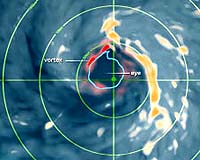| . |  |
. |
Manila (AFP) July 14, 2010 Typhoon Conson ripped across the Philippines on Wednesday, killing at least 20 people as it destroyed shanty towns and caused widespread blackouts that brought the nation's capital to a standstill. Sixty other people were reported missing after Conson hit the Southeast Asian archipelago late on Tuesday, then whipped the main island of Luzon throughout the night with wind gusts of 120 kilometres (74 miles) an hour. "The wind howled like a child screaming," said Rigor Sambol, 52, a father of six who lives in a coastal shanty town on the outskirts of Manila that was partly destroyed. "It was so strong, our houseboat nearly got flipped over. I had to take the children one by one to a nearby gym where they spent the evening on the cold floor." Some of the flimsy slum homes erected by squatters along the coast were swept away entirely, leaving the shocked residents to scavenge scrap wood to build makeshift shelters, according to an AFP reporter there. Authorities across Luzon said 20 people had been confirmed killed, including two squatters from a vast lakeside shanty town near Manila who were crushed when their homes collapsed. Fifty-seven fishermen were also missing, while three other people were unaccounted for south of the capital after flooding swept away their shanties, according to the military. The Philippines is in the so-called typhoon belt of the Pacific. Up to 20 typhoons sweep through the country each year, killing hundreds of people. But the ferocity of Conson, which was the first typhoon of the season, took many people in Manila by surprise after the state weather service said it would only strike provinces to the north of the capital. Electricity was knocked out for most of Manila, causing major problems for businesses and forcing schools to close in the city of 12 million people. The national energy transmission company said 80 percent of Manila remained without power by nightfall and that it could take until Friday for supplies across the city to be restored completely. Other areas of Luzon may have to wait until the weekend, the company warned. The capital's overhead railway system was also shut down due to the power outage, while international and domestic flights were disrupted. For workers in office towers that were relying on back-up generators, it was still difficult to make telephone calls on both landline and mobile networks, while Internet services were also interrupted. Businessman Antonio Ramon Ongsiako, a director at the Financial Executives Institute of the Philippines, told AFP that the power cuts would likely cost the country 10 billion pesos (216 million dollars) a day in lost opportunities. Conson blew past Luzon and into the South China Sea on Wednesday morning, and by nightfall was heading towards Hainan Island in southern China. President Benigno Aquino let rip at the state weather service for not warning Manila's residents that Conson would hit the city. "This is not acceptable," Aquino told red-faced weather service officials at an emergency meeting of rescue agencies. "We rely on you to tell us where the potential problems are. "All the agencies have adequately met their responsibilities at this point in time but your information is sorely lacking. We have had this problem for quite a long time." The ill-equipped Philippine weather service came in for criticism in September last year when it failed to warn the residents of Manila about the threat from Tropical Storm Ketsana, which killed 464 people. jvg-mm-cgm-kma/txw
Share This Article With Planet Earth
Related Links Bringing Order To A World Of Disasters When the Earth Quakes A world of storm and tempest
 Surprisingly Regular Patterns In Hurricane Energy Discovered
Surprisingly Regular Patterns In Hurricane Energy DiscoveredBarcelona, Spain (SPX) Jul 14, 2010 Researchers at Mathematics Research Centre and Universitat Autonoma de Barcelona have discovered the mathematical relation between the number of hurricanes produced in certain parts of the planet and the energy they release. The distribution is valid for all series of hurricanes under study, independent of when and where they occurred. The research, which will be published on sunday online ... read more |
|
| The content herein, unless otherwise known to be public domain, are Copyright 1995-2010 - SpaceDaily. AFP and UPI Wire Stories are copyright Agence France-Presse and United Press International. ESA Portal Reports are copyright European Space Agency. All NASA sourced material is public domain. Additional copyrights may apply in whole or part to other bona fide parties. Advertising does not imply endorsement,agreement or approval of any opinions, statements or information provided by SpaceDaily on any Web page published or hosted by SpaceDaily. Privacy Statement |